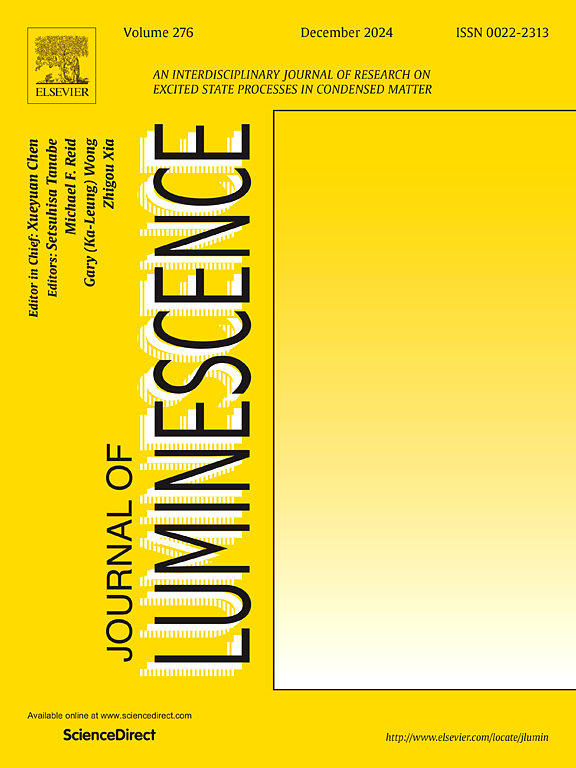Effect of Ca content on optical, scintillation and thermoluminescence performance of LuAG:Ce ceramic scintillators
IF 3.3
3区 物理与天体物理
Q2 OPTICS
引用次数: 0
Abstract
Ce doped Lu3Al5O12 (LuAG:Ce) is a scintillator that attracts attention due to its high light yield, fast scintillation response, and excellent radiation resistance. In this study, optical and scintillation performance of Ca2+ co-doped LuAG:Ce ceramics, fabricated by two-step sintering combined with air annealing, was investigated. In addition, thermoluminescence (TSL) of these LuAG:Ce,Ca ceramics was studied. Decrease of TSL glow curve intensity was observed with increasing Ca2+ content. In particular, the TSL signal becomes hard to detect when Ca2+ content is higher than 0.1 at.%. Ca2+ co-doping is also beneficial for suppressing the slow scintillation component. Sample with Ca2+ co-doping level of 0.1 at.% shows an optimized light yield of 11 700 ph/MeV with scintillation decay showing a high fast component/total intensity ratio of 98.3 %, which is the highest value ever reported in the Ca2+ co-doped LuAG:Ce.
Ca含量对LuAG:Ce陶瓷闪烁体光学、闪烁和热释光性能的影响
Ce掺杂Lu3Al5O12 (LuAG:Ce)因其发光率高、闪烁响应快、耐辐射性能优异而备受关注。本文研究了两步烧结结合空气退火法制备Ca2+共掺杂LuAG:Ce陶瓷的光学和闪烁性能。此外,还研究了LuAG:Ce,Ca陶瓷的热释光(TSL)特性。随着Ca2+含量的增加,TSL发光曲线强度降低。特别是当Ca2+含量高于0.1 at.%时,TSL信号变得难以检测。Ca2+共掺杂也有利于抑制慢闪烁成分。样品与Ca2+共掺杂水平为0.1 at。结果表明,最佳光产率为11 700 ph/MeV,闪烁衰减显示出高的快速组分/总强度比为98.3%,这是迄今为止报道的Ca2+共掺杂LuAG:Ce的最高值。
本文章由计算机程序翻译,如有差异,请以英文原文为准。
求助全文
约1分钟内获得全文
求助全文
来源期刊

Journal of Luminescence
物理-光学
CiteScore
6.70
自引率
13.90%
发文量
850
审稿时长
3.8 months
期刊介绍:
The purpose of the Journal of Luminescence is to provide a means of communication between scientists in different disciplines who share a common interest in the electronic excited states of molecular, ionic and covalent systems, whether crystalline, amorphous, or liquid.
We invite original papers and reviews on such subjects as: exciton and polariton dynamics, dynamics of localized excited states, energy and charge transport in ordered and disordered systems, radiative and non-radiative recombination, relaxation processes, vibronic interactions in electronic excited states, photochemistry in condensed systems, excited state resonance, double resonance, spin dynamics, selective excitation spectroscopy, hole burning, coherent processes in excited states, (e.g. coherent optical transients, photon echoes, transient gratings), multiphoton processes, optical bistability, photochromism, and new techniques for the study of excited states. This list is not intended to be exhaustive. Papers in the traditional areas of optical spectroscopy (absorption, MCD, luminescence, Raman scattering) are welcome. Papers on applications (phosphors, scintillators, electro- and cathodo-luminescence, radiography, bioimaging, solar energy, energy conversion, etc.) are also welcome if they present results of scientific, rather than only technological interest. However, papers containing purely theoretical results, not related to phenomena in the excited states, as well as papers using luminescence spectroscopy to perform routine analytical chemistry or biochemistry procedures, are outside the scope of the journal. Some exceptions will be possible at the discretion of the editors.
 求助内容:
求助内容: 应助结果提醒方式:
应助结果提醒方式:


